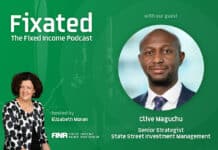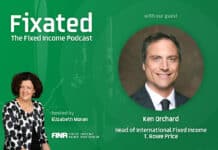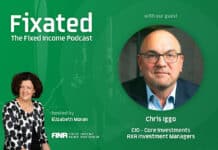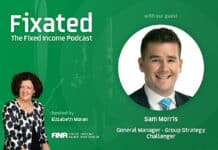
By AXA IM’s Chris Iggo
The prevailing narrative remains one of impending global interest rate cuts and the avoidance of recession. In terms of portfolio management, I have not seen much to spur on any significant changes. High yield bonds have demonstrated their resilience to equity market volatility, but some government bonds have become more expensive. It turns out that second quarter (Q2) US corporate earnings were solid, underpinning ongoing equity investor confidence. The global macroeconomic backdrop is still supportive for markets and the 60:40 model is having a good vintage.
Rates landing
There is some disagreement among commentators as to whether current market pricing for central banks is realistic. US interest rates are priced to fall to around 3.0% by the end of 2025; Eurozone interest rates are expected to decline to 2.25% and UK rates are expected to land at 3.5%. The most common criticism of market pricing is from those who believe the global economy is not weak enough nor has inflation fallen sufficiently to allow rates to decline by that much. The precise path of interest rates remains to be seen. The Fed is expected to reverse around half the tightening it put in place in 2022-2024, which I would suggest is consistent with the pattern seen in previous monetary cycles.
Curve rather than outright duration
The arguments will rage though and there is clearly uncertainty around how US fiscal policy will impact interest rates following November’s election. For bond investors the key is that the yield curve should normalise, with yields on shorter maturity bonds set to decline in line with the policy rate, while longer dated yields are likely to be more anchored to current levels. In most markets, 10- year yields have fallen a fair way over the course of Q3 so far. On a medium-term view they are pushing the bottom of the fair value range, and in the absence of any negative shocks, I do not see a lot of room for yields to fall meaningfully lower. The seven-to-10 year maturity bucket of the US Treasury market has delivered a 5.4% total return over the last year. The trend return since 1985 has been 3.4%.
Range finder
My hunch is that medium-to-long-term core bond yields are going to be in a range similar to the early 2000s. Core 10-year bond yields traded between 4.0% and 5.5% until the global financial crisis led to a shift lower in 2009. At the time, core inflation in the US averaged around 2.0%. It was slightly lower in the UK and post-Economic and Monetary Union Europe. Assuming inflation is going to be slightly above the global central bank target of 2%, then bond yields in a 4% to 5% range is a reasonable expectation. Add on 100-150bp of investment grade credit spread and there is your potential 6%-plus return from a high-quality bond portfolio for the next few years. Bond investors deserve that after the disaster of the quantitative easing period. Taking the ICE Global Corporate bond index, annualised returns have been 4.5% since 1996, 3.67% since 2006, and 2.6% since 2016. A meaningful portfolio allocation to fixed income needs more expected return than that delivered over the past decade.
Fiscal focus coming
The debate around fiscal policy is likely to be more interesting in years to come. In the UK, the Labour government has warned of a tough Budget as it attempts to bring down the level of borrowing. There will be tax increases and, more likely than not, they will be progressive, targeting areas like inheritance and capital gains. Fiscal decisions should be more important in determining long-term growth prospects as they can provide long-term (dis)incentives to certain targeted economic behaviour. Getting the balance right between fiscal prudence, boosting growth, increasing the quality of core public services, and setting a more sustainable agenda in energy usage is not going to be easy. In the US there has been little tangible policy discussion ahead of the election. The consensus is that, given enough rope, both Presidential candidates would tend towards fiscal expansion; and this will form the basis of many future discussions with clients. Yet the bond market has not priced in anything meaningful in terms of higher risk premiums in real yields. A funding crisis is either ahead of us or is not going to happen. But with 10-year yields below 4% it gives fixed income bears an excuse to be short.
High yield trumps most
High yield, especially in the US, remains a favoured asset class into year-end. The index yield is currently 7.25% which embodies 317bp of spread above a reference government bond yield curve. The total return on the index is 6.25% so far this year, in line with the long-term trend. There should be a little more with no real alarms in terms of refinancing strains. The spread between the CCCrated part of the index and the BB-rated proportion has remained remarkably stable. If credit conditions were systematically deteriorating, we should expect the spread to widen. As the Fed cuts rates and the underlying yield curve steepens, high yield bonds should get some capital appreciation bonus. So returns look set to remain healthy, the main risk being a sustained equity market correction (more than what happened in early August), given the correlation between stocks and high yield bond returns.
(Performance data/data sources: <LSEG Workspace DataStream, Bloomberg, AXA IM, as of 28 August 2024, unless otherwise stated). Past performance should not be seen as a guide to future returns.

































